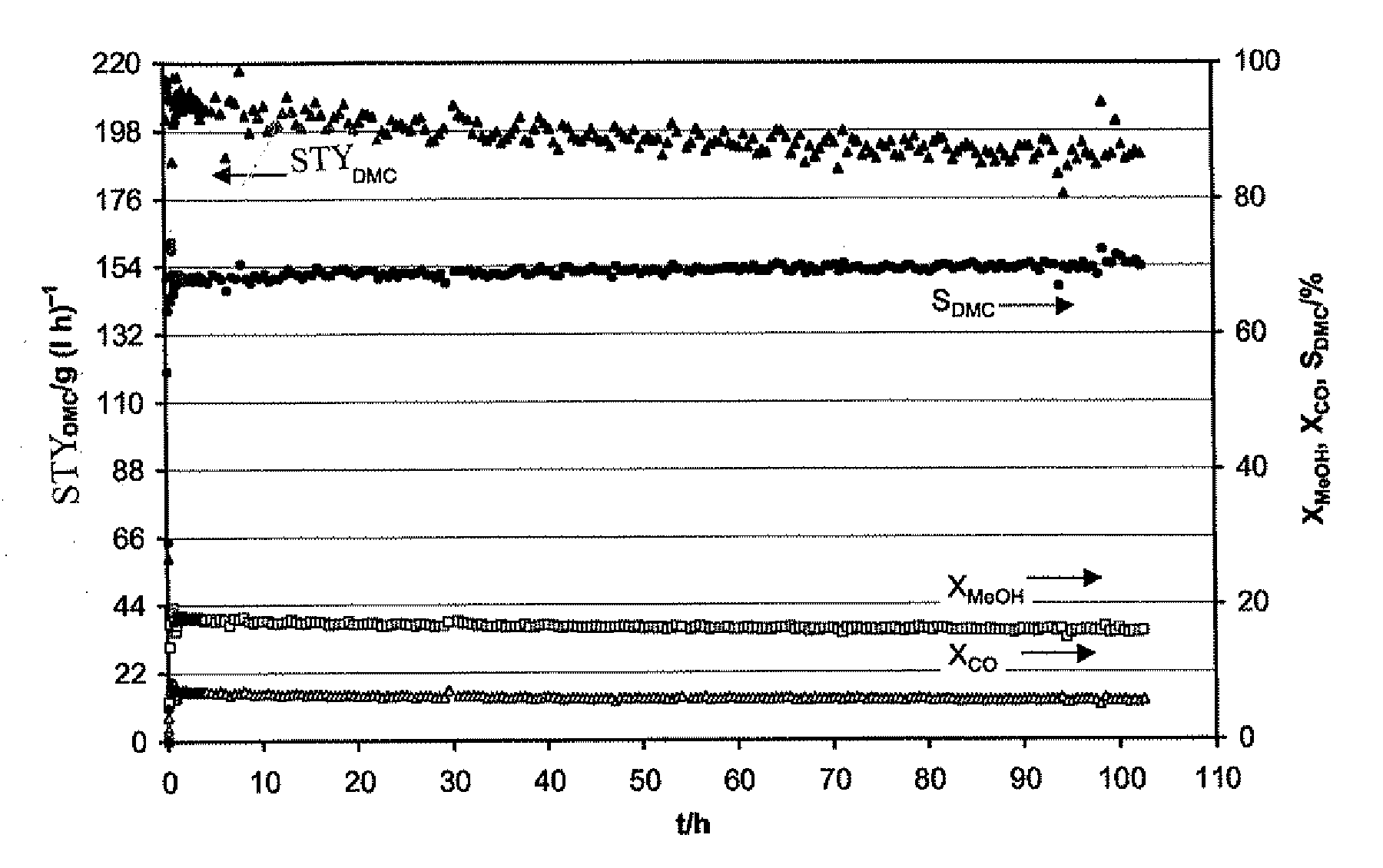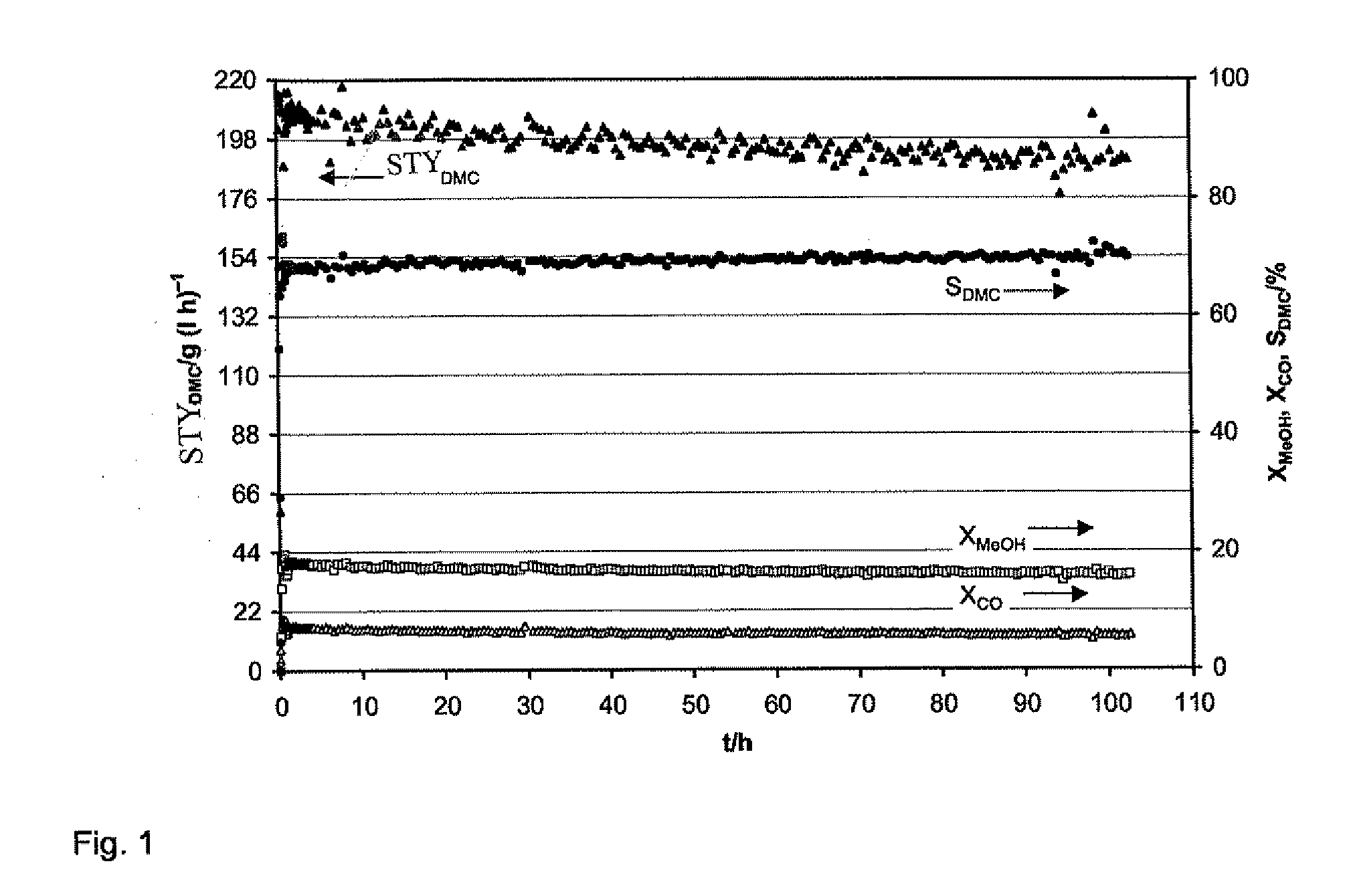Catalyst for the Synthesis of Dimethyl Carbonate in the Gas Phase
a dimethyl carbonate and catalyst technology, applied in the field of improved, can solve the problems of limited secondary treatment temperature window, insufficient temperature to produce an active copper phase from copper compounds, and inability to assess the stability of the catalyst system
- Summary
- Abstract
- Description
- Claims
- Application Information
AI Technical Summary
Benefits of technology
Problems solved by technology
Method used
Image
Examples
example 1
[0062]Preparation of the modified zeolite (precursor): A solution of 2.0 g of Cu(II) acetate in 100 g of distilled water in a sealable vessel at room temperature is added with 5 ml of ammonia solution (25%) with stirring with a magnetic stirrer. Owing to the formation of the Cu(II) tetrammine complex, the color of the solution turns from light-blue into a deep dark-blue. The pH value should be about 9. Following addition of 5.0 g of Na—Y zeolite (dried at 120° C.), the vessel is sealed, and this is stirred for 24 h at 25° C. Thereafter, suction filtration is effected, and the blue precipitation is washed three times with 50 ml of ammonia solution (0.5%). The Cu(II)NH4Na—Y zeolite is initially dried at room temperature and subsequently at 120° C. Finally, this is calcined in air at 400° C. The Cu(II)HNa form being formed is gray-green at 400° C. and green-blue in cooled and rehydrated state (humidity). The Cu content of the catalyst referred to as precursor is 7.8% as determined by c...
reference example 1
[0065]Production of the precursor is effected in accordance with Example 1. In contrast to Example 1, the precursor—without further pretreatment—is exposed to a mixture of MeOH / CO / O2 / Ar / He=0.36 / 0.48 / 0.06 / 0.05 / 0.05 (GHSV: 3000 h−1) in a tubular flow reactor under normal pressure. This precursor B contains 8.2% copper and shows only low activity with respect to the target reaction. The values illustrated in Table 2 are obtained, demonstrating that significant space-time yields cannot be achieved with the modified zeolite without subsequent activation by thermal treatment in the ranges as indicated.
TABLE 2Oxidative carbonylation of methanol into DMCon precursor B of Reference Example 1STYDMCT (° C.)XMeOH (%)XCO (%)SDMC (%)SDMM (%)SDME (%)(g lcat−1 h−1)130≈0≈0≈0140≈0≈0≈01504125175818160711816672317010110157521XMeOH: conversion of methanol,XCO: conversion of CO,SDMC: selectivity of dimethyl carbonate formation,SDMM: selectivity of dimethoxymethane formation,SDME: selectivity of dimethyl ...
example 2
[0066]Example 2 differs from Example 1 in that the precursor is activated using the following procedure:
[0067]2 g of the blue-green granulate is treated with 50 ml / min of a reduction gas mixture (argon with 5 vol.-% hydrogen). The temperature is raised from 25 to 350° C. with 10 K / min, and the reducing medium is maintained for 30 min. After switching to inert gas (50 ml / min, Ar with O2<10 ppm), the temperature is raised to 800° C. at a heating rate of 10 K / min and maintained for 15 h. Thereafter, cooling in a stream of inert gas is effected.
[0068]The catalyst C thus obtained has a copper content of 8.3% and is white. Upon exposure to air (oxygen, moisture), the color changes from white to blue-green at room temperature.
[0069]This catalyst C is exposed to a mixture of MeOH / CO / O2 / Ar / He=0.36 / 0.48 / 0.06 / 0.05 / 0.05 (GHSV: 3000 h−1) in a tubular flow reactor under normal pressure. The activity of the catalyst is comparable to that described in Example 1. Depending on the temperature, the va...
PUM
| Property | Measurement | Unit |
|---|---|---|
| time | aaaaa | aaaaa |
| pressures | aaaaa | aaaaa |
| temperatures | aaaaa | aaaaa |
Abstract
Description
Claims
Application Information
 Login to View More
Login to View More - R&D
- Intellectual Property
- Life Sciences
- Materials
- Tech Scout
- Unparalleled Data Quality
- Higher Quality Content
- 60% Fewer Hallucinations
Browse by: Latest US Patents, China's latest patents, Technical Efficacy Thesaurus, Application Domain, Technology Topic, Popular Technical Reports.
© 2025 PatSnap. All rights reserved.Legal|Privacy policy|Modern Slavery Act Transparency Statement|Sitemap|About US| Contact US: help@patsnap.com


